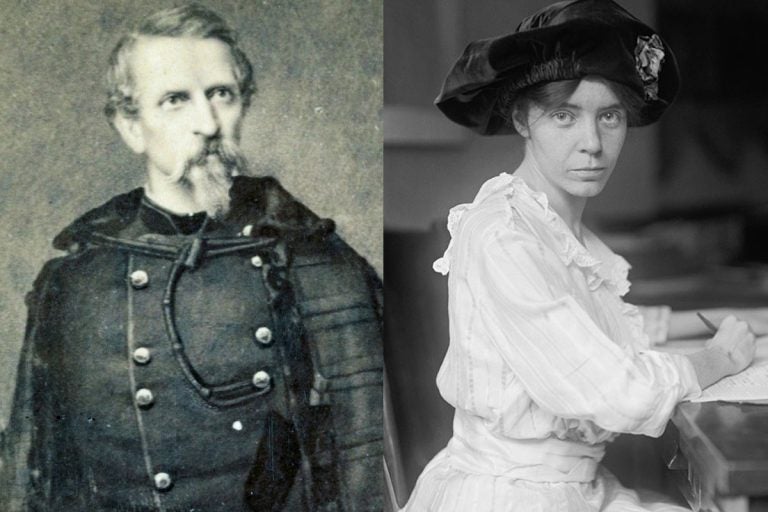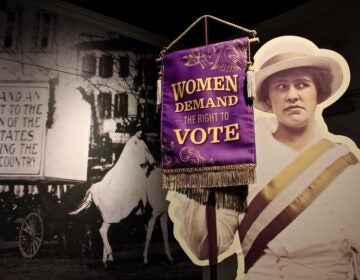Should Alice Paul replace N.J. ‘war hero’ in Washington, D.C. statue gallery?
A prime mover behind the 19th Amendment could get a statue replacing Philip Kearney, a Civil War general.

Philip Kearny, Jr. (June 2, 1815 – September 1, 1862) was a United States Army officer, notable for his leadership in the Mexican-American War and American Civil War. He was killed in action in the 1862 Battle of Chantilly. Alice Stokes Paul (January 11, 1885 – July 9, 1977) was an American suffragist, feminist, and women's rights activist, and one of the main leaders and strategists of the campaign for the Nineteenth Amendment to the U.S. Constitution, which prohibits sex discrimination in the right to vote. (Library of Congress)
One died while commanding troops during the Civil War. The other helped secure women the right to vote by passing the 19th Amendment. Which should be honored in the halls of the U.S. Capitol?
The historical debate was thrown into stark relief Monday as the New Jersey Senate considered a bill that would replace a statue of Brig. Gen. Philip Kearny with one of suffragette Alice Paul in the National Statuary Hall Collection in Washington, D.C.
Supporters of the idea said Paul’s significant contributions as a women’s rights activist have not been adequately remembered by history.
“Women’s history needs to be recorded. For too long we’ve studied one half of the story in our history,” said Lucienne Beard, executive director of the Alice Paul Institute in Mt. Laurel.
Paul, who was born in Mt. Laurel in 1885 to Quaker parents, led what Beard called the “radical” wing of the women’s suffrage movement. “These were the women who picketed in front of the White House, were thrown in jail for picketing, and in jail went on hunger strikes and were force fed,” she said.
After the adoption of the 19th Amendment in 1920, Paul pushed for the passage of the Equal Rights Amendment and urged states to ratify it. “She worked for those ratifications from a wheelchair in a nursing home through the 1970s,” Beard said. Paul died in 1977, and the ERA was never adopted.
Despite Paul’s accomplishments, not everyone believes she deserves a statue in the Capitol.
State Sen. Joseph Pennacchio, R-Morris, suggested that Paul’s legacy should be commemorated — but not at the expense of Kearny’s.
“Philip Kearny was a veteran. Philip Kearny was a war hero. Philip Kearny gave his arm in [the Mexican-American War] and the ultimate of sacrifices during the Civil War,” Pennacchio said.
Kearny helped found the New York Stock Exchange before turning to a career in the military. He was shot dead during the Battle of Chantilly in 1862. The Hudson County town is named for him.
On Monday, the state Senate approved legislation to begin the process of replacing the statue by a vote of 28-5, with seven senators not voting. It was one hundred years and one day after New Jersey ratified the 19th Amendment. It now goes to the Assembly for action.
If the bill becomes law, the state will formally ask the federal Joint Committee on the Library of Congress to approve the replacement of the statue in the National Statuary Hall Collection.
The collection contains 100 statues, two donated by each state, of people who have made significant accomplishments to history, including Jefferson Davis (Mississippi), Helen Keller (Alabama), and Standing Bear (Nebraska).
New Jersey’s other statue is of Richard Stockton, a signer of the Declaration of Independence.
For Beard, of the Alice Paul Institute, replacing the statue would be huge. She said it would be as much about informing the public as it would be about honoring Paul herself.
“I think it would educate a lot of people who have never heard the name Alice Paul,” she said. “But I think beyond that it’s symbolic. It shows that we value someone and their contributions.”
WHYY is your source for fact-based, in-depth journalism and information. As a nonprofit organization, we rely on financial support from readers like you. Please give today.




